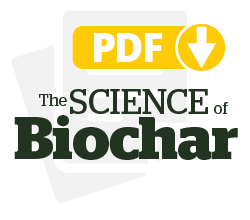Soil Remediation

What Is Soil Remediation?
Soil remediation is the process of making contaminants non-bioavailable or removing contaminants such as pesticides, hydrocarbons, and heavy metals from soil. Once these contaminants enter the soil, they can easily seep into groundwater or get absorbed by both wild and cultivated plants. These contaminants are harmful to all forms of life, from the most basic of bacteria up to plants and animals, including human beings, which makes removing them critical not just to the health of any plants that may be growing in that soil, but also anyone that comes in frequent contact with it as well. Therefore, these contaminants need to be removed or somehow neutralized. One method that has become increasingly popular is the use of horticultural carbons, like biochar, in soil remediation efforts.
How Does Soil Remediation With BioChar Work?
At Wakefield BioChar, we achieve soil remediation with our carbon-based biochars. By taking plant-based biomass and heating it to up to 900 degrees Celsius without oxygen present, the carbon in this biomass changes from long chains into stable carbon rings. These carbon rings possess a slight negative electrical charge, which interacts with the positive charge that many contaminants possess. The difference in electrical charges causes the contaminants to be trapped within the carbon structures of the biochar and prevents them from polluting the soil or seeping into groundwater. The surface interactions of biochar are complex. Other ways that biochar can capture a contaminant are organometallic bonding, cation exchange, precipitation and π- π donor interactions.
Rejuvenating soil health with BioChar products is as easy as mixing the biochar in with soil during composting, potting, or tilling. How much biochar you use will depend on how the soil is used and how badly it needs remediation, but most gardens will want roughly 5% – 10% of the soil in the planting area to be biochar.
Why Is Soil Remediation Important?
As previously mentioned, soil remediation is critical not just for the health of the soil, but the health of all organisms that interact with that soil. Heavy metals and chemicals that contaminate soil can eventually reach groundwater and spread out of control, leading to a host of health issues for any organism, humans included, that interacts with that water. Whether that means drinking said contaminated water or eating flora or fauna that consumed the contaminated water, it can lead to lead poisoning, allergies, damaged immune systems, and even cancer if not addressed.
Companies found responsible for soil or groundwater contamination can face paying millions of dollars in damages, such as Pacific Gas & Electric’s $333 million payout for its role in the Hinkley groundwater contamination incident. Thus, environmental remediation is a critical concern for any business working with dangerous pollutants.
Soil remediation also plays a role in reducing environmental impact in other, less obvious ways. By using activated carbon, also referred to as activated charcoal, in soil to restore that soil’s health, you can reduce the need for chemical fertilizers and improve crop yields, enabling farmers and growers to do more with less. By getting more out of soil already in use, both hobbyist gardeners and businesses can reduce the need for dedicating acreage to growing, as well as cut down on the toxic byproducts created by chemical fertilizers during their production and use.
By implementing soil remediation with BioChar, you can cut down on your environmental impact, no matter how large or small your soil footprint may be.
Proven History of Biochar Effectiveness
The use of biochar for soil remediation of heavy metals has been studied since at least 1998. Research conducted at universities and testing done in the field demonstrate the ability of porous carbon-based chars, like biochar, to adsorb metal out of liquid and soil. The ability of biochar to retain metals is based on the cation exchange capacity (CEC) found within the porous structure. Biochar is made from taking a biomass, like trees, and heating them to high temperatures (400°C to 900°C) with no oxygen present. The physical change to the biomass is incredible. The carbon in the biomass is changed from long carbon chains to a very stable carbon rings. What used to be xylem and cellulose is now a porous carbon network within a char that is greater than 60% carbon. Inside the network of pores is a slight negative charge. This negative charge interacts with the positively charged metals to keep them within the biochar and not in the water or the soil.
Two Basic Soil Remediation Choices
It is important to understand what you want to do with the soil that has metals in it that are potentially harmful. There are two basic choices: remediation or using the soil to grow plants. For remediation purposes, the biochar can be added at higher concentrations (>50% v/v). For plant growth, in general, the mixture of biochar with the soil needs to be between 5% and 10%. You can do both things at once. We recommend having a layer of biochar mixed with the contaminated soil at high concentrations. Then add a layer of mulch, clean soil, compost and 5% to 10% biochar to create a rich, organic, clean layer for plants to grow.
If you can’t create this bi-layer of biochar, then we recommend a 10% mix (v/v) of biochar at least 6 inches deep in the soil and let it have as much time as possible to interact with the contaminated soil. Allowing biochar time with the soil will activate all of the qualities biochar can provide. This will increase contact time with the metals and allow the metals to enter into the pores of the biochar. The soil will see a natural increase in microbes, to include mycorrhizal fungi. The increase in microbes can aid in the remediation of the metals and prepare the soil for the introduction of plants. For situations where remediation will be part of the application, the use of a wood-based feedstock has shown better retention of the metals. A wood-based feedstock will have less ash and a higher surface area. These qualities are important to maximize the interaction with the contaminants. The result will be better soil and a better world.
Scientific Support For Biochar In Soil Remediation
Excerpt from the paper:
“Ved Parkash and Sukhbir Singh from the Department of Plant and Soil Science, Texas Tech University, conducted research on salinity stress is among the major abiotic stresses prevailing in arid and semiarid areas such as the southern high plains of the United States. In these areas, both declining qualities of groundwater and cultivation practices have resulted in increased accumulation of salts in the root zone. The occurrence of excessive salts in the root zone is detrimental to plant growth and economic yield. Recently, biochar has received great consideration as a soil amendment to mitigate the detrimental impacts of salinity stress. However, the effectiveness of biochar to mitigate the salinity stress depends on the feedstock type, pyrolysis temperature and time, soil type and properties, and plant species. Therefore, a pot experiment in a greenhouse was conducted to 1) examine the effects of salinity stress on physiology, shoot and root growth, and yield of eggplant (Solanum melongena L.), and 2) evaluate the potential of hardwood biochar and softwood biochar to mitigate the damaging effects of salinity stress on eggplant.”
Excerpt from the paper:
“Most biochars have a greater surface area, and after aging can also have a greater cation exchange capacity than some soils, and are thus capable of increasing the retention of cationic PTEs in soil. Furthermore, by raising soil pH, biochars can also further enhance the immobilization of PTEs on soil minerals and organic matter.
Biochars may also retain PTEs through more specific types of surface interactions (e.g., ligand exchange), and precipitation and redox reactions. Changes in pH caused by biochar will also influence these reactions.”
Excerpt from the paper:
“Biochar (BC) can be used to remediate soils contaminated with potential toxic elements (PTEs). However,the efficiency of BC to immobilize PTEs in highly contaminated floodplain soils under dynamic redox con-ditions has not been studied up to date. Thus, we have (i) quantified the impact of pre-definite redox con-ditions on the release dynamics of dissolved aluminum (Al), arsenic (As), cadmium (Cd), copper (Cu),nickel (Ni), and zinc (Zn) in a highly contaminated soil (CS) (non-treated) and in the same soil treated with 10 g kg 1 biochar based material (CS + BC), and (ii) assessed the efficacy of the material.”
Excerpt from the paper:
“Biochar has been proposed as an amendment to remediate mine land soils; however, it could be advantageous and novel if feedstocks local to mine land sites were used for biochar production. Two different feedstocks (pine beetle–killed lodgepole pine [Pinus contorta] and tamarisk [Tamarix spp.]), within close proximity to mine land–affected soils, were used to create biochars to determine if they have the potential to reduce metal bioavailability. Four different mine land soils, contaminated with various amounts of Cd, Cu, Pb, and Zn, received increasing amounts of biochar (0, 5, 10, and 15% by wt). Soil pH and metal bioavailability were determined, and the European Community Bureau of Reference (BCR) sequential extraction procedure was used to identify pools responsible for potential shifts in bioavailability. Increasing biochar application rates caused increases in soil pH (initial, 3.97; final, 7.49) and 55 to 100% (i.e., no longer detectable) decreases in metal bioavailability. The BCR procedure supported the association of Cd with carbonates, Cu and Zn with oxyhydroxides and carbonates, and Pb with oxyhydroxides; these phases were likely responsible for the reduction in heavy metal bioavailability. This study proved that both of these feedstocks local to abandoned mining operations could be used to create biochars and reduce heavy metal bioavailability in mine land soils.”
Excerpt from the paper:
“Anthropogenic sources such as paints, pesticides, mining, metal piping, burning of coal and military training may release hazardous levels of metal(loid)s into soil environment (Herath et al. 2015; Singh et al. 2011). Soil in military shooting range are reputed to build up high concentrations of metal(loid)s such as Pb, Cu and Sb, which can become a point-source of pollution in local catchments (Rajapaksha et al. 2015).
Bullets lodged in local soil can release metal(loid)s in a wide range of species or forms, e.g., hydroxides, carbonates, sulfates and carboxylates (Rajapaksha et al. 2015), and their bioavailability threats soil and water quality of surrounding ecosystems, and associated agricultural crop quality and human health (Herath et al. 2015; Suthar et al. 2008; Vithanage et al. 2015). Bioavailable metal fraction is the most critical phase in the soil, as it is the absolute concentration of particular heavy metal(loid)s that can have impact on a variety of organisms. Bioavailability tends to result in the bioaccumulation attacking biological organisms which leads to the toxicological bioavailability.”
Excerpt from the paper:
“Traditional “dig‐and‐dump” or dredging practices to remove contaminated soils and sediments are costly, and there is a need to develop cost‐effective in‐situ remediation strategies. One option is the addition of a sorbing agent to the contaminated soil or sediment. For this, activated carbon (AC) – defined as a carbonaceous material that has undergone activation (e.g., steam, chemical treatment) to increase its sorption properties − is often used as a sorbing agent for in‐situ remediation. AC can be made from both biomass and anthracite or lignite coal, by pyrolysis followed by activation through steam or strong base.”






